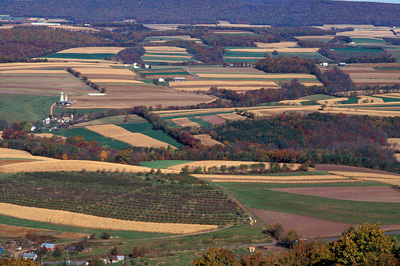|
|
 |
PAGE 63 / 102 |
 |
Unit 2: Applying Ecological Principles
Crop Rotation
 |
Crop rotation in the Mahantango Creek Watershed, Pennsylvania. (Scott Bauer, USDA ARS) |
Crop rotation is a foundational practice in sustainable agroecosystems because it is a primary means for farmers to diversify their system, improve soil quality, and prevent pest problems. We tend to think of crop rotations as being cyclical, following a repeated pattern from season to season. But the reality for farmers is often more complicated: The type and sequence of crops on any given farm will vary to meet the evolving business and management goals of the farmer. In addition to the key cash crops grown on the farm, rotations can also include ‘break’ or ‘filler’ crops, cover crops, and fallow. Lastly, each field on the farm may have its own rotation pattern distinct from other fields, so farmers will actually be managing a number of complex rotations that change over time.
What goals do farmers have in mind as they develop and modify rotations on their land? Here is a list of some of the many benefits of crop rotation:
Crop Rotation Goals
-
Maintain soil quality.
-
Reduce insect, nematode and disease problems.
-
Control weeds.
-
Diversify marketable products to increase profitability over the long-term.
-
Enhance ecological diversity.
-
Provide year-round employment for farm labor.
-
Minimize off-farm inputs.
|